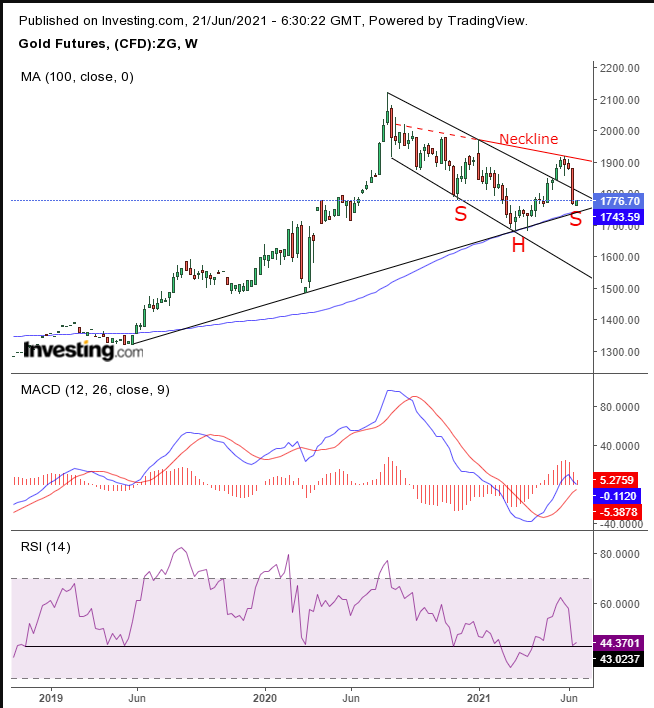Gold found its footing this morning, after the precious metal last week registered its worst weekly performance in 15 months.
The 6.2% lower settlement at the close of the previous week's trade puts the yellow metal at a fundamental value of 46%, when calculating the StateSide “M2” money supply of $3,870, even after including the supply increase for the metal of 201,480 tonnes.
While Wells Fargo forecasts that an inflation breakout will push yields back above 2% in the coming months—for the first time since mid-2019—for now, yields have plummeted, after the market priced in the Fed's new, more hawkish stance which could include a hike in interest rates in 2023...or even sooner.
Current, falling yields decrease the allure of Treasuries, but burnish gold's luster, which may be why the precious metal has steadied. And on the technical chart, Wells Fargo's prediction could end up being in alignment.

Whatever your interpretation of the reason, 10-year Treasury yields topped out as investors rushed back into US sovereign bonds. However, that could slow this week, allowing yields to find support above the uptrend line since the August low.
The 200 DMA joined the uptrend, revealing its technical significance, reinforcing its support, solidifying the uptrend line into the bottom of a rising channel.

Gold’s drop last week pushed it back into a falling channel. On its face, we should expect the price to retest the March-April lows. However, notice, where gold found support.
Bulls picked it up at the exact same level as the November low. Coincidence? Maybe. But it could also be the formation of a large H&S continuation pattern.
On the weekly chart, it’s clear that gold is still in a long-term uptrend, sitting above its uptrend line, intertwined and bolstered by the 100 weekly MA. The MACD and the RSI found support above the lows since 2018.
How would that jibe with Wells Fargo’s call that rates could be headed back above 2%? Earlier we said that gold enjoyed newfound demand thanks to dropping yields. So wouldn't that mean rising yields would siphon off funding for gold?
To begin with, the question is predicated on yields actually rising. And of course, they may not.
Second, if yields do get that high, it’s because investors are NOT buying Treasuries, since rates move in opposition to the sovereign bonds themselves. So however higher rates may go, they will still not compensate for the inflation risk, which potentially erodes a bond’s future cash flow.
What then do people buy to preserve the value of their capital? Historically, that's been gold.
It seems like we’ve just made a case for gold on the fundamentals, but, again, that depends on whether inflation is systemic or transient as well as how long will it stick around and how bad it might become.
In other words, the future is still unknown, and that includes the outcome of this trade, which is also complex. Therefore, we'll provide technical guidelines for just the short- to medium-term.
Trading Strategies
Conservative traders should wait for the medium downtrend to match with the long-term uptrend.
Moderate traders would go short if gold falls below the long-term uptrend line or go long if the price closes above the falling channel.
Aggressive traders could go long in order to capture a potential rebound, having reached the long-term uptrend line, reinforced by the 100 weekly MA, banking on an inflation-driven gold rally.
As important, if not more so than the analysis, is a sound trading plan that fits your needs. Here are the basic parameters for a coherent plan:
Trade Sample
- Entry: $1,775
- Stop-Loss: $1,750
- Risk: $25
- Target: $1,900
- Reward: $125
- Risk:Reward Ratio: 1:5
Author's Note: The above is just a sample, not the actual analysis. That’s in the body of the text. Our analysis could be wrong. Or it could be right, but conditions may change. Even if our analysis is spot-on and conditions remain consistent, the sample may fail.
Your personal circumstances will have a determining impact on your results. Proper money management incorporates your budget, temperament and of course timing. Until you learn how to do that, you may follow our samples for the purpose of education, not profit, or you’ll end up with neither. We guarantee that, and there's no money back.
